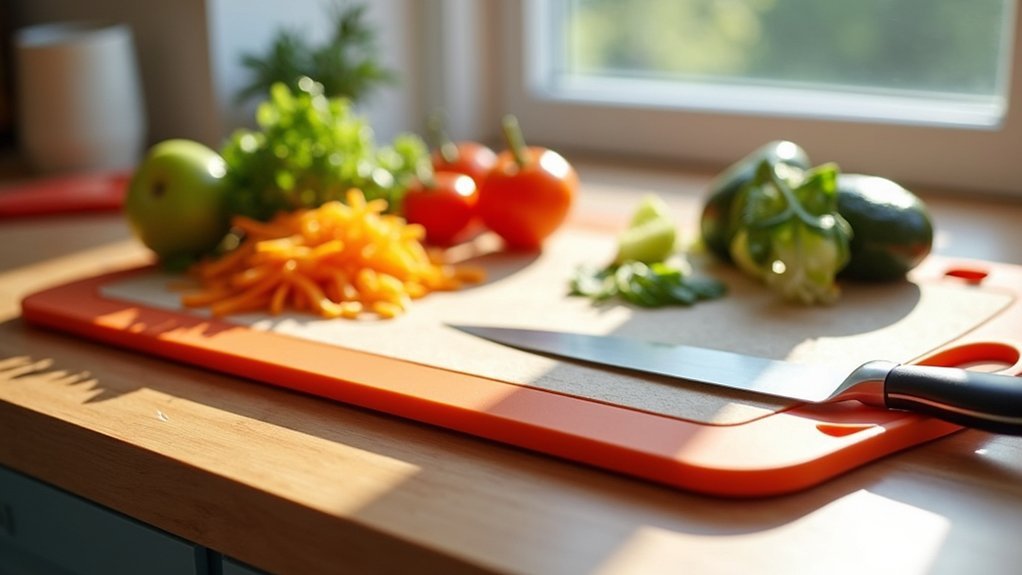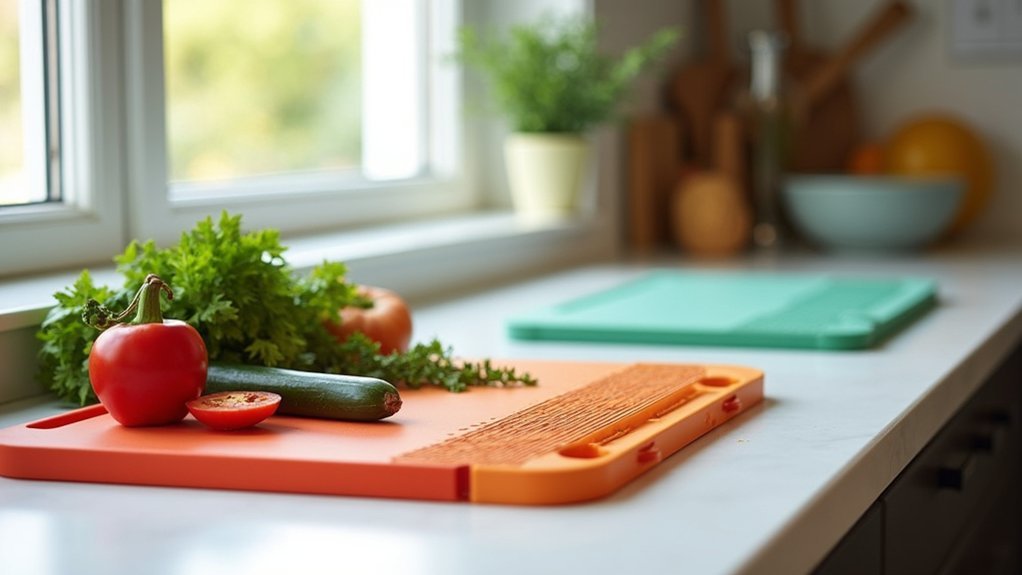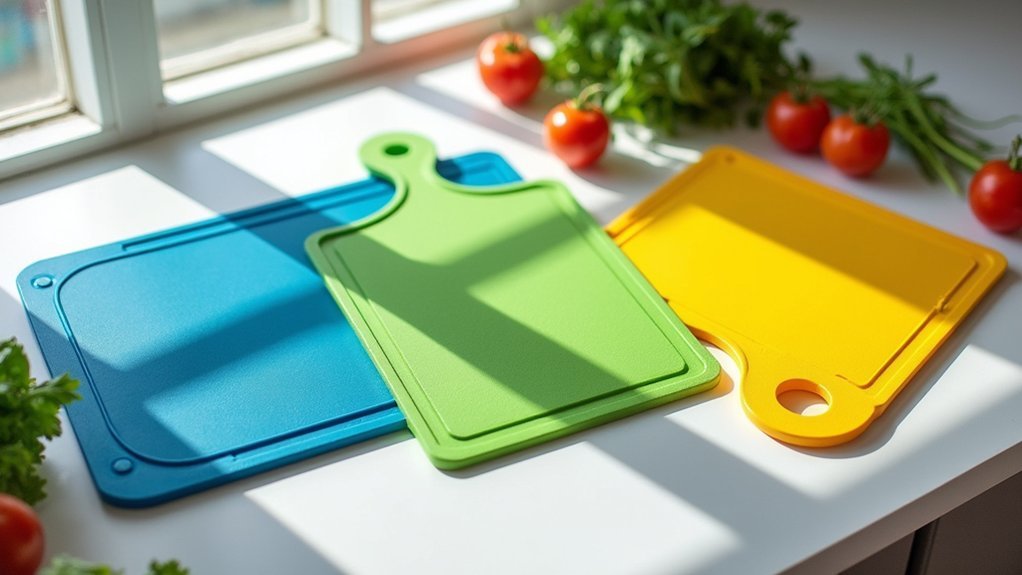Adaptive cutting boards transform kitchen independence with features like food stabilizers, non-slip bases, and ergonomic designs. You’ll find options with suction cups for counter stability, pegs or spikes to hold food firmly, and angled surfaces for comfortable prep work. These specialized tools help anyone with limited hand mobility or dexterity challenges regain cooking confidence and safety. Priced between $30-$60, these investments offer long-term benefits beyond just meal preparation.
Why Adaptive Cutting Boards Are Game-Changers for Kitchen Independence

While traditional cutting boards present significant challenges for those with limited hand mobility, adaptive cutting boards revolutionize the cooking experience by prioritizing accessibility and independence.
You’ll find these innovative boards equipped with stabilization features like nails, spikes, or pegs that hold food firmly in place, eliminating the need for you to grip items with both hands. Their non-slip bases guarantee the board stays put while you work, reducing accident risks and frustration.
Many designs include angled cutting surfaces and allow multi-directional approaches, letting you work from your most comfortable position.
Cleverly engineered cutting angles adapt to your body’s natural movements, making food preparation feel intuitive rather than restrictive.
The empowerment these boards provide extends beyond mere functionality—they restore your confidence in the kitchen, reducing dependence on others for meal preparation. Typically ranging from $30 to $60+, these adaptive tools represent a worthwhile investment in kitchen autonomy.
Whether you’re managing a disability or age-related dexterity issues, these tools transform cooking from challenging to enjoyable.
Top Features to Look for in Adaptive Cutting Boards
Selecting the right adaptive cutting board can dramatically impact your kitchen independence. Look for boards with secure food holding mechanisms like stainless steel spikes or adjustable clamps that prevent slipping during cutting tasks. Adaptive cutting boards are especially important for stroke survivors who are relearning kitchen skills during rehabilitation.
| Feature | Benefit |
|---|---|
| Suction cups/Non-slip base | Keeps board firmly in place on countertops |
| Food securing mechanisms | Allows one-handed operation while cutting |
| Versatile functionality | Helps with multiple tasks beyond cutting |
Don’t overlook the importance of stability features like rubber suction feet that anchor the board to your counter. Materials matter too—choose food-grade, BPA-free options that are easy to clean and sanitize. For maximum comfort, select boards with ergonomic designs that reduce fatigue during extended food preparation sessions.
How These Specialized Cutting Boards Improve Daily Life

Specialized cutting boards transform everyday kitchen tasks from frustrating challenges into manageable activities for individuals with mobility limitations. They provide independence you might’ve thought was lost, allowing you to prepare meals without assistance.
With non-slip suction cups and food guards, you’ll experience enhanced safety while cutting, minimizing the risk of injuries. The secure food-holding features eliminate the need to constantly reposition ingredients, saving you time and energy. Innovative designs incorporating peg-based systems enable users to customize their cutting board for different food preparation needs.
Safety features like non-slip suction cups and food guards transform cutting tasks, reducing injury risks while conserving your valuable energy.
These adaptive tools offer psychological benefits too. You’ll gain confidence in the kitchen, leading to greater participation in family meals and social gatherings. The ability to prepare your own food fosters a sense of accomplishment and improves overall well-being.
Many users report significant improvements in their quality of life through regained kitchen independence.
Frequently Asked Questions
How Do I Clean and Maintain an Adaptive Cutting Board?
Clean your adaptive cutting board with soap and water, then hand-dry thoroughly. Maintain wooden boards with mineral oil every 3-5 weeks. For plastic boards, check for cracks regularly. Use soft brushes and store upright after cleaning.
Are Adaptive Cutting Boards Dishwasher Safe?
Yes, most adaptive cutting boards are dishwasher safe. You’ll find this feature particularly convenient as it allows you to thoroughly sanitize your board without manual scrubbing. Always check the manufacturer’s specific instructions though.
What Price Range Should I Expect for Quality Adaptive Boards?
For quality adaptive boards, you’ll typically spend between $40-$100. Budget options start around $10, while high-end models with advanced features may cost over $100, sometimes reaching $153. Discounts can reduce prices by 30%.
Can Adaptive Cutting Boards Be Used With All Knife Types?
Yes, you can use adaptive cutting boards with all knife types. They’re designed to hold food securely in place while you cut, allowing compatibility with standard kitchen knives, specialty knives, or even attached pivoting knives.
Are There Portable Adaptive Cutting Boards for Travel or Small Kitchens?
Yes, you’ll find portable adaptive cutting boards perfect for travel or small kitchens. They’re lightweight (about 1.25 lbs), compact (as small as 7.5″×7.5″), and feature non-slip feet and raised edges for stability anywhere.
In Summary
You’ll find adaptive cutting boards invaluable for maintaining your kitchen independence. They’re designed to work with your unique needs, not against them. Whether you’re dealing with mobility issues, vision impairments, or dexterity challenges, these specialized tools make food prep safer and more enjoyable. Don’t settle for struggling with standard kitchen equipment when these smart solutions can transform your cooking experience.





Leave a Reply